Sangram is a leading contemporary painterly representational painter who primarily paints from observation. He currently has two shows in New York City as part of the Steven Harvey Fine Art Projects, current paintings showing until December 31, 2009 at the Schlesinger Gallery, 24 E 73rd St. NY, NY and a show of drawings up until December 19th at the Coleman Bancroft LLC 35 East 67th Street, 4th fl NY, NY
You can also see this show on the Steven Harvey Fine Art gallery website..
 Click image for larger view
Click image for larger view
Sangram Majumdar Eclipsed, oil on linen, 78 x 90 inches, 2009
All works by Sangram Majumdar, courtesy of Steven Harvey Fine Art Projects
Please note that for all of these images a larger view is available if clicked (unlike many other images on this blog)
Sangram was extremely generous to take time out of his busy schedule to answer a few questions for this blog. Another excellent read is the 2008 interview at Neoteric Art with him.
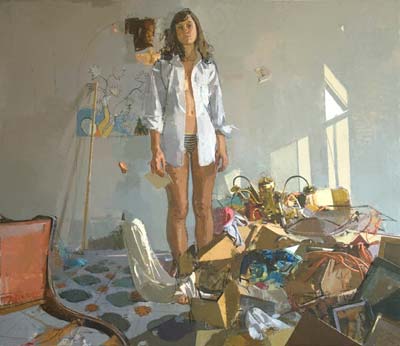
Material Thoughts, oil on linen, 78 x 90 inches, 2009
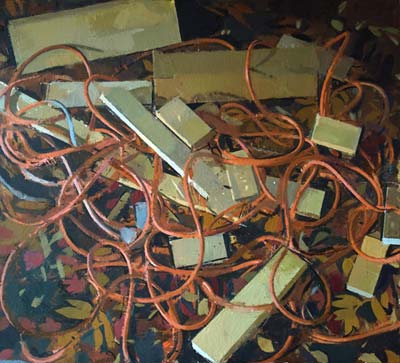
The Maze, oil on linen, 38 x 42 inches, 2009
Larry
Some of your recent work appears looser and more abstract, especially in the figurative paintings, than your work of a few years ago. Can you talk about where you want to go with your more recent work?
Sangram Majumdar
The words “looser” and “abstract” don’t fit for me. I am not an abstract painter because I am interested in an overall but specific experience that is tied to our world in a very concrete way.
Instead I think the language is kept more open, with visible pauses and breaks in the paint handling and materiality of the surface of the object. These passages are not planned but are a direct outcome of my working process – which is fairly basic – a decision is made, it is edited/rethought, and a new decision is made, sometimes parallel, other times contrary to the initial decision. This change is also reflective of a greater shift in my thinking of “painting” – the object and “painting” –the experience. I want a greater range of experience embedded in the painting itself, so the history of the object is important for me, not just in the process of making, but as a part of the aesthetic and visual construct. Right or wrong, they are all right at the end of the day if the painting works.
I suppose in my work, more and more I am trying to find a stronger connection between the subject matter, the process, and the painted object. So, what I don’t paint in a way is becoming more important to my narrative.
Larry
Much of your work seems based on observation in some manner. Can you talk about why this is important to you? When does observation stop giving you enough for the painting’s needs?
Sangram Majumdar
It is important because it always gives me something new and something unexpected. It can be extremely familiar in one sense, and in the next, utterly foreign. As, many artists have noted, what we see is intrinsically tied to our memory, and in many cases it is very telling of what we want to see. So, in that sense it is truly subjective, and only “true” to our sense of truth.
What becomes really critical in the sustained paintings are the pauses between the painting sessions if I am working from life. Sometimes the problem will be that I would have a section I would work on, and I’ll get “blinders” on, and after 2-3 hrs realize that everything needs to be moved an inch or two one way or another. So, the decisions, the planning before or after the sessions from life are really important to tying it all together. The longer the work goes on, I paint more without any direct reference, and towards the end of the painting, I paint from life very little. However, it is not a full-proof system, so it’s really about what the painting needs.
Larry
You said in another interview at Neoteric Art that “As a painter, my concerns really revolve around form, space and the specificity of the experience” Do you think in going after the “specificity of the experience” allows you opportunities for greater invention and perhaps a more universal statement?
Sangram Majumdar
All I know is that those concerns are really what drive the work, especially the latter part of my comment. I try to pay attention to the painting and maintain an open dialogue throughout the process. Sometimes the “inventions” are really about looking, and paying attention and removing “me” from it, at least for a while.
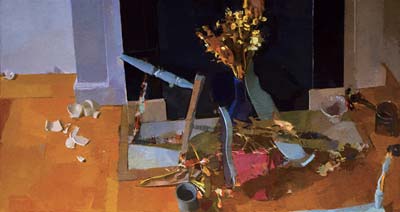
Home, oil on linen, 44 x 84 inches, 2008
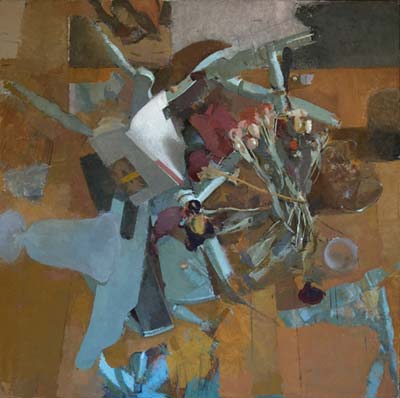
Built to Spill, oil on linen, 46 x 46 inches, 2007
Larry
In a few of your paintings like, “Built to Spill”, “The Maze”, and “Home” you show magnificent piles of cluttered papers and trash, broken objects strewn about, perhaps from recent violence, and other seemingly random arrangements of forms. You then seem to revel in creating order out of this chaos; such as finding gestural pathways and rhythms in the shape and color relationships. While this is visually stunning and this alone is enough for great painting, there also seems to be some kind of emotional tone or narrative going on. Can you tell us something about what you are going after with these paintings?

Islands, oil on linen, 40 x 48 inches, 2009

Removal, oil on linen, 28 x 32 inches, 2009
Sangram Majumdar
Well, to me they begin to tie together the visual complexities that I am drawn to formally with the narrative and metaphoric potential of these weathered and discarded objects. At the heart of it, is really my interest in the nature of history, how it’s built, one on top of another, it’s repetitious and often circuitous nature, and how we create links – sometimes in a linear manner, other times a big event will connect itself to another event from years past.
A while ago I was giving a talk, and I started noticing these moments of “detritus” in my work – going all the way back to grad school. And I realized that it’s not simply that I enjoyed painting those passages the most, but there might be something more in them. “Built to Spill” was actually a painting of the same forms in a fairly conservative, straightforward still-life. I remember working on it, liking it, and then realizing that it was one of the most boring things ever! It looked “like” other paintings I loved – so, at that moment I decided to dump the whole thing on the floor and rework the painting. It was revelatory, in that for the first time there was no plan, and the entire painting was open.
Around that time, my thinking began shifting, and the paintings with figure groupings left my head. It’s not that I am against artifice – but the paintings can’t be artificial – they have to be real, in a physical sort of way – like a person is real. It has be a “living, breathing” thing for me. I wanted a stronger, richer connection to the materiality and process. So, I stopped doing sketches more or less, and decided to make the painting the surface where everything would be worked out! Sometimes this would lead to multiple paintings on the same surface, vastly different structurally but keenly tied to a continued thought.
So, in the newer works I am choosing the objects more carefully, because of their functional and formal significance. I am more interested in how, what they are changes, after their prescribed functionality has been derailed. It’s the debris or the remains that become visually and historically dense with possible meanings and hints at new, unintended structures and places. The paintings “Removal” or “Islands” are about this. For me it’s when suddenly we get a glimpse into the layers of history against a new, clean surface that excites me. Looking at and looking through, being aware of the surface and the process, become the two critical experiences that connect the past and the present for me. It’s why I paint.
Here are a few more of Sangram’s paintings that are among my favorites.
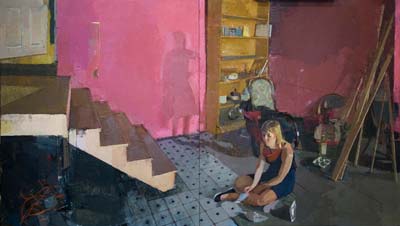
Presence, oil on linen, 60 x 108 inches, 2008
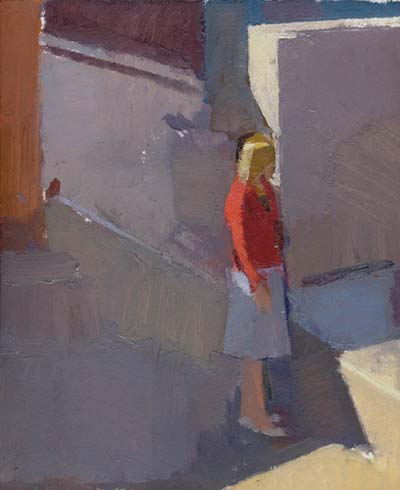
Steps, oil on muslin on panel, 12 x 9 inches, 2008
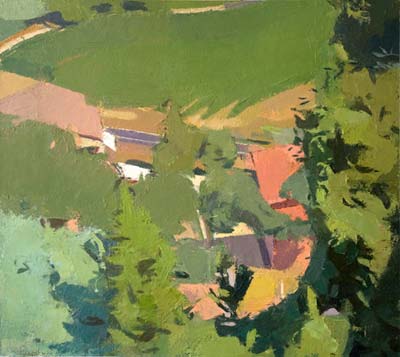
Midday Sun, oil on paper on panel, 19 x 21 inches, 2008
From Sangram’s website bio information:
Sangram Majumdar was born in Calcutta, India and received his BFA at the Rhode Island School of Design and his MFA at Indiana University.
Selected venues for solo exhibitions include Steven Harvey Fine Art Projects at Gallery Schlesinger, NY and Coleman Bancroft LLC, NY; Ann Nathan Gallery, IL; Wright State University Art Galleries, OH; Lyon College, AR; Indiana University Art Museum, IN; He has participated in group exhibitions at the The Painting Center, NY; Alpha Gallery, MA; Steven Harvey Fine Art Project, NY; Museum of Art in Rochefort-en-Terre, France; Aichi Prefectural Museum of Art in Japan; Indiana University, IN; College of William and Mary, VA; Maryland Art Place,Delaware Center for Contemporary Art, DE; Rochester Institute of Technology, NY; C. Grimaldis Gallery, MD; Madison Art Center, WI among others.
His awards include the 2009-10 Marie Walsh Sharpe Studio Space Program Grant, MICA Trustees Award for Excellence in Teaching, Maryland State Art Council Individual Grant in Painting, the Elizabeth Greenshields Foundation Grant, and the Tony Munavec Overseas Fellowship to Italy. His work has also recently been published in drawing textbooks: Drawing Essentials: A Guide to Drawing from Observation (Oxford University Press, 2008), Drawing: Structure and Vision, (Prentice Hall, 2008) and Exploring Life Drawing (Thompson Delmar Publishing, 2007). He has been a Visiting Artist at the International School of Painting, Drawing and Sculpture, Ball State University, Indiana University, Princeton University, College of William and Mary, Ecole Superieure des Beaux Art, de Lorient, University of New Hampshire, University of Wisconsin-Stout, Wright State University, Dreyfoos School for the Arts, Design and Architecture Senior High School in Miami and the Rhode Island School of Design-Palazetto Cenci.
Since 2003, he has been teaching painting and drawing at the Maryland Institute, College of Art. He currently splits his time between Baltimore, MD and Brooklyn, NY.

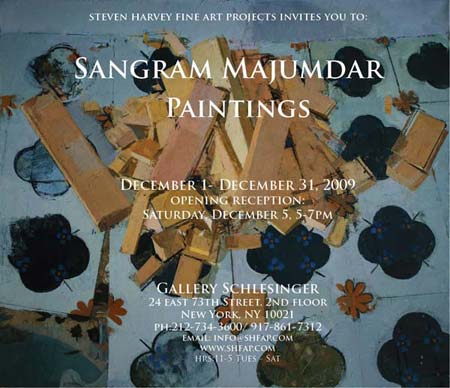




Sangram is a very fine painter indeed!
Great questions, great answers. Sangram, working in a direct, observational mode, has always seemed to be a mainly intuitive painter which would mean that a lot of these answers are based on after-the-fact reflection. It’s awesome how intense his observations about his painting process are.
Thanks Chris, I agree with what you say about the intensity of his observation of his painting process. It would be fascinating to watch him paint and also talk about his work.
an amazing artist. Thank-you for the interview!
What painting does Eclipsed remind you of?
Might be fun.
I am talking about the underlying composition which has ties to another painting.
Nothing wrong here and I am not trying to trash this artist because many artist have done this and I think it is smart but mostly I thought it would be a fun puzzle.
Just wondering if I am the only one who sees it.
Not sure what the composition overall reminds me of, but the pose of the figure makes me think of Sickert
I’m not sure about the composition or artist either but I’m getting a feeling there is inspiration from Matisse’s odalisques.
Of course the palette and treatment is more sober and somber than Matisse but Sangram does appear to me to respond to what Diebenkorn often took from Matisse in terms of a larger color/shape/pattern arrangements.
I was going to say the pose seemed Danae-like, especially with the light falling across her legs and pelvis but that is probably too far-fetched.
Hi Larry and John well lets see if you think I’m nuts ha ha.
The way this artist thinks and constructs his images seems very cerebral to me at first but then intuition takes center stage after a while. Boy art can be wonderful when you allow the intuition to stretch like this. Anyways I’ll stop babbling along how much I like the process of this artist and just say that after enjoying his work and especially ECLIPSED there was something bothering me and then it hit me, Van Gogh’s Cafes Terrace came to mind, so I looked at the two images side by side and the parallels were there.
If you spend time with the two images for a while more and more subtle abstract parallels become visible. I just thought it might be fun and educational to see this and I think the artist is smart in the subtle ways that he did this…
Of course, I could be dead wrong but it sure looks as if.
Van Gogh’s painting Cafe Terrace, Arles at Night is what I assume you are talking about. OK so there are two doorways on the left in perspective and starry background on a field of blue and leafy plant on the right border with some light form below it.
Interesting parallel between these two very dissimilar artists.
I’m not convinced though.
The structure of the space recalls an older Dutch artist whose name I won’t mention but the curtain opening into a room was one of his standard devices. I know Van Gogh mentioned him in his journals so who knows…
Interesting painter. Hope to get down to see the show before it closes.
You don’t have to be convinced that’s the rub, I am just saying it’s interesting and just another way of perceiving a personal perception for certain individuals like who knows, he might of been in stage one of building the comp and might of looked at or memory of the VG image came to mind and got an idea and after all isn’t that what we are doing, creating and inventing.
Invention is usually piggybacked off of established ideas, like a burr in nature sticks to clothes is then followed by inventing and creating Velcro. But I guess one needs be ready for invention like an owl perched and waiting for his opportunity to present itself then grab it when opportunity knocks is pretty well the same way a lot of us artists get their ideas. Therefore, this image could have easily been piggy backed off of a Van Gogh image. I mean didn’t Japanese prints influence Van Gogh and others. Katsushika Hokusia / The Sazai Pavillion of the Temple of Five Hundred Rakan influenced Claude Monet/ Terrace at Sainte-Adresse and the similarities are there.
Anyways, I did see a lot more similarities in this image than you did but bottom line I learned a little something and it was fun.
If he was influenced and the more I look, I think it was …smart.
Van Gogh’s painting did pop to mind, given the stars in the wallpaper and the title (though both the figure and the “moon” are eclipsed here). My guess is that this probably popped into Sangram’s mind as he was moving and editing the light fixure, saw an “eclipse” within the change, liked it, memory led to Van Gogh, and he decided to go with the star pattern. But I think that this is part of his process of discovery while working, particularly when working from intuition rather than observation. Investigating the process of making changes and how these could lead to further layers of interpretation. Islands is a fabulous example for showing this creation of more than one 3-dimensional surface on the canvas, worlds below the surface. Those blocks of wood and tiles do most definitely appear to be floating on that floral world below, and it is a delightful visual experience.
I also love Sangram’s colors and objects which reappear, mallard blues, creams, pinks, patterns in fabric and tile. I believe I read somewhere that he had a brief foray in illustration during his undergraduate years; I can sense its presence in his works, a bit like seeing overlapping storyboards. A marvelous painter.
Just seeing the responses since i last posted…
I did not think of the Van Gogh, but I did see the paper lantern and wallpaper as sun/moon and stars. I think the Van Gogh comparison is sort of interesting. but not because I think that Sangram was thinking of that painting (he wasn’t). but because I enjoy seemingly far-fetched comparisons/parallels when looking at paintings (as well as looking at other things).
Looks like some very good painting…I’m hoping to go see the show before it comes down. Two artists that immediately came to my mind were Euan Uglow (whose work you rarely see in the US) and Jerome Witkin (a teacher of mine from Syracuse) I’d like to see these paintings in person…thanks for posting!
I recently came across your blog and have been reading along. I thought I would leave my first comment. I don’t know what to say except that I have enjoyed reading. Nice blog. I will keep visiting this blog very often.
Claudia
http://paintingdrawing.net
Francis is on the money but what an exciting combination of influences.
I recently came accross your blog and have been reading along. I thought I would leave my first comment. I dont know what to say except that I have enjoyed reading. Nice blog. I will keep visiting this blog very often.
Alisha
http://sketchingdrawing.com
thanks so much for this site…i am really pleased to have found it, rarely have i found so many of my favorite contemporary painters in one place, much less an interested audience for such painting.
i really enjoy Majumdar’s work, and find it very interesting and enjoyable in many ways… and have to agree with Francis–Uglow was the first artist i thought of, looking at ‘Eclipsed’…but first I thought, WOW–what a beautiful painting!!
The painting “Material Thoughts” grabs my attention the most. The perspective and play on shadow make this work very intriguing and the figure is very mysterious.